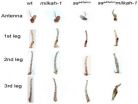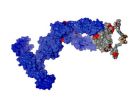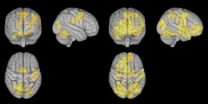(Press-News.org) The scientists - Boris Kuzin, Ekaterina Nikitina, Roman Cherezov, Julia Vorontsova, Mikhail Slezinger, Olga Zatsepina, Olga Simonova, Grigori Enikolopov and Elena Savvateeva-Popova - studied Drosophila flies, in whose genome weak mutations of two different genes were combined. The paper is published in the PLoS One. They concluded that these mutations synergistically strengthen their mutual phenotypic expression. In other words, the aggregate effect of these mutations is much greater than that which can be produced by one of them individually.
The mutant flies bred by the scientists have a number of significant peculiarities. The experiments have shown that even low doses of X-ray irradiation (not exceeding 10 R) can cause serious defects in those flies' legs.
In contrast, in the flies with normal (unchanged) genome such defects could not be caused even by doses of irradiation hundreds of times higher. What is more, the combination of the two mutations worsened the long-term memory impairment, earlier observed in the flies with only one of the mutations.
In addition, the mutant flies' cells are less resistant to the so-called superoxide radicals.
Superoxide radicals are ions which appear in cells under both normal and pathological conditions. Superoxide radicals have very high rates of reactivity, which is why their excess damages many types of bio-molecules, including DNA. The mutations in Drosophilaflies' cells lowered their ability to resist that damage.
What was already known
According to the scientists, mutations in the genome of the experimental flies affected two genes: CG5017 and spineless. Both these genes are involved in regulation of many different functions, a large number of which still remain unknown. The team of researchers from MIPT, RAS and Cold Spring Harbor Laboratory has set a goal to reduce this white spot. The scientists started with the already known facts, i.e., that the CG5017 gene mutations impair insects' memory, and that mutations in spineless bring about a number of defects in morphogenesis. In Drosophila flies, spineless mutations affect leg and eye formation and disrupt the development of neuronal dendritic structure.
The CG5017 gene encodes the proteins which belong to the Nucleosome assembly protein (NAP) super-family. These proteins are the so-called nucleotropic chaperones, i.e., they are involved in the formation of functioning chromosomes' elementary units, namely, nucleosomes.
It should also be noted that in most multicellular organisms the DNA molecules, located in the cell's nuclei, are not simply wound up double spirals, but very complex structures linked with protein molecules.
Spineless is a transcription factor, which means that this gene is involved in the process of transcribing genetic information from DNA to RNA, that is, RNA synthesis. This gene is important for cells also because it regulates the transcriptional activity of many other genes.
The protein encoded by spineless regulates the synthesis of other proteins, which, in their turn, perform many important functions. Mutations appearing in spineless do not directly impact the structure of this or that protein. Yet, such mutations can either seriously limit, or even render impossible, the synthesis of many different protein molecules at once.
Spineless-controlled genes are responsible for the proper development of an animal. Even by the first half of the twentieth century,spineless gene mutations were ranked among the so-called homeotic mutations. Such mutations do not stop the process of the organism's formation, but direct it in the wrong way.
"Where we expected to see antennae, there emerged leg morphological structures with altered segmentation. It later turned out that the formation of eye structures and nervous cells had also been disrupted," said Boris Kuzin, the leading author of the article presenting the research.
Boris Kuzin is a staff scientist of the DNBICT Brain Stem Cells Laboratory and the head of the Genetic Mechanisms of OrganogenesisResearch Group at the Institute of Developmental Biology (RAS).
What was discovered
The new research has shown the following: the spineless gene is also involved in long-term memory formation and detoxification. Spineless, and the proteins it controls, help the cell to get rid of exogenous toxins (i.e., originating outside the cell) and endogenous ones (in this case, those which were produced inside the cell following the irradiation).
According to Boris Kuzin, the combination of the weak spineless and CG5017 gene mutations in a genome has a synergistic effect and results in the weakening of spineless (ss) products' functions. The organisms of fruit flies with these particular mutations cannot manage the simultaneous processes of detoxification and morphogenesis.
"It seems that the disruption of detoxification leads to aggravation of the defects, which appear in the process of limb formation in response to even low radiation doses. It looks like these mutant flies lack the functionally active spineless (ss) products necessary for the simultaneous control of development and detoxification," said Kuzin.
It should be emphasized that many genes have functional analogues, which work as partial substitutes, i.e., if a gene cannot function properly because of a mutation, other genes can, to some extent, compensate for this disruption. Besides, gene mutations can be strong (the affected gene is fully dysfunctional) and weak (the affected gene retains some of its functions).
What is means
The discovery, as the scientists state in their article, can shed some light on the problem of individual irradiation sensitivity. It is known that low doses of radiation sometimes result in serious inborn defects, and sometimes leave no traces. In part, it is connected with the a priori random nature of ionizing radiation, but there are also a number of genetically-based molecular-biological differences, many of which have not been yet defined.
"These results may have broader implications beyond the model organism. In particular, they may indicate an increased risk of pathological response to radiation in humans carrying hypomorphic mutations of these genes in their genome (note that both genes are highly evolutionarily conserved). Such individuals may be more vulnerable than the bulk of the population to even low levels of radiation, such as those delivered during routine medical procedures, prolonged air travel, or long term residency on the premises with high levels of radon," wrote the researchers.
In the scientists' opinion, with the advent of broadly available genome sequencing it may become possible to single out the mutations linked with increased radiation sensitivity in individuals. The data can be used, for example, when choosing diagnostic procedures for such patients in order to ameliorate their increased vulnerability to radiation.
The fact that the CG5017 gene mutation effect is enhanced by a mutation in spineless (ss), and vice versa, confirms that different genes do interact with each other. The researchers suppose that the CG5017 gene product launches the process of synthesis of other proteins, which, in their turn, are necessary for the complete functioning of the spineless gene products.
A further detailed study of such interactions will help the scientists to get answers to many questions. For example, how multicellular organisms developed, how they acquired the ability to resist various toxins at different steps of evolution and how they managed to use this ability and long-term memory while adapting to a new ecological niche.
For Reference: about the researchers
The leading expert of the research project is Boris Kuzin, a staff scientist of the DNBICT Brain Stem Cells Laboratory and the head of the Genetic Mechanisms of Organogenesis Research Group at the Institute of Developmental Biology (RAS). Among Kuzin's scientific interests are gene transcription regulation processes, determination and differentiation of cells, and morphogenesis.
Grigori Enikolopov is the head of MIPT's DNBICT Brain Stem Cells Laboratory. Enikopolov is among the scientists awarded with the so-called "mega-grants", i.e., target financing as part of a Russian Federation government program, aimed at inviting leading specialists to universities.
For Reference: about the genes and what comes with them
DNA is able to store the information because its component blocks, the nucleotide pairs, are joined together in a certain order, the so-called nucleic acid sequence. The DNA matrix is the basis for the synthesis of another molecule, RNA. This molecule differs fromDNA in chemical content and structure: in most cases, RNA is a single, not a double, strand.
RNA molecules serve either as the matrix for protein synthesis (every three RNA nucleotides correspond to one amino acid in the protein), or perform their own function, e.g., some RNAs act as ferments, inducing biochemical reactions.
DNA, as was mentioned above, does not appear isolated in the cell, but always comes with a complex of proteins. These proteins are responsible for selectively "switching off" a certain number of genes in the cell. This, in turn, makes the process of RNA synthesis, ortranscription, impossible. There is also a group of proteins which, on the contrary, perform the function of launching RNA synthesis. Such proteins are called transcription factors.
Studying of the transcription control mechanisms (and today we know plenty of them) is the main task of molecular biology. There are many reasons for this.
First, it is gene transcription that defines the type of cells during the organism's development. Because of the differences in the processes of transcription, some cells become neurons, and others turn into liver, or, skin.
Second, understanding the differences in gene expression can shed light on the process of aging, the mechanisms of degradation of normal cells into cancer, and on many other disease progressions.
Third, during evolution, many important characteristics linked with the emergence of a new trait did not appear because of the arrivalof some absolutely new kind of protein. These characteristics were shaped by changes in the pattern of development of a certain organ. For example, our ancestors got rid of the tail obviously not because some new protein appeared, but because at a particular stage of embryonic development the group of genes responsible for tail vertebrae formation got "switched off".
Fourth, the switching "on" and "off" of the genes in a certain sequence supports many vital processes, including memory consolidation, digestion, muscle mass growth during long-term physical activity, and many others.
Many genes interact with each other, and this interaction can develop according to different scenarios. A protein encoded by one gene can engage with a protein encoded by another gene, and the resulting product, in its turn, will launch the RNA synthesis from a third, or a fourth, gene. Or, it might, on the contrary, suppress the synthesis of yet another protein.
These days the scientists are actively studying such interactions.
INFORMATION: END
MIPT experts reveal the secret of radiation vulnerability
MIPT experts reveal the secret of radiation vulnerability; The discovery can help both in predicting the consequences of irradiation and understanding the fundamental patterns of morphogenesis
2014-05-15
ELSE PRESS RELEASES FROM THIS DATE:
MIPT scientists develop algorithm for anti-aging remedy search
2014-05-15
The scientists – Alexander Zhavoronkov, Anton Buzdin, Andrey Garazha, Nickolay Borisov and Alexey Moskalev– have based the new research on their previously-developed methods in the study of cancer cells. Each cell uses particular schemes of molecular interaction, which physiologists call intercellular signaling pathways.
A signaling pathway is a chain of sequential events of interaction between certain molecules which make the cell respond to stimulation. For example, hormone molecules first interact with the cell's membrane receptors, then the receptors engage with the ...
Next frontier: How can modern medicine help dying patients achieve a 'good' death?
2014-05-15
(TORONTO, Canada – May, 15, 2014) -- The overall quality of death of cancer patients who die in an urban Canadian setting with ready access to palliative care was found to be good to excellent in the large majority of cases, helping to dispel the myth that marked suffering at the end of life is inevitable.
"Fear of dying is something almost every patient with advanced cancer or other life-threatening illness faces, and helping them, to achieve a "good death" is an important goal of palliative care," says Dr. Sarah Hales, Coordinator of Psychiatry Services, Psychosocial ...
Study shows young men increasingly outnumber young women in rural Great Plains
2014-05-15
Lincoln, Neb., May 15, 2014 -- In many rural communities hard hit by decades of population declines, young men increasingly outnumber young women, a new study of Kansas and Nebraska census data shows.
In places with 800 or fewer residents, the proportion of young men increased by an average of nearly 40 percent as people went from their teens to their 20s.
Those findings suggest leaders should consider the needs of young women in their economic and community development plans, said Robert Shepard, a University of Nebraska-Lincoln doctoral candidate ...
Most NHL players peak by age 29: Study
2014-05-15
A new University of British Columbia study identifies when the clock runs out on an NHL player's peak performance, giving team executives insight into how best to build a roster.
The study by Sauder School of Business professor James Brander found that the performance of forwards peaks between the ages of 27 and 28. Defencemen are best between 28 and 29, and the performance of goaltenders varies little by age.
The forthcoming study to be published in the Journal of Quantitative Analysis in Sports also reveals that players performed close to their peak levels for a ...
Learning from sharks
2014-05-15
This news release is available in German.
Custom-tailored antibodies are regarded as promising weapons against a multitude of serious illnesses. Since they can accurately recognize specific structures on the surface of viruses, bacteria or cancer cells, they are already being deployed successfully in cancer diagnostics and therapy, as well as against numerous other diseases. The stability of the sensitive antibodies is a decisive factor in every step, from production and storage to therapeutic application.
A team of researchers headed by Dr. Matthias J. Feige and ...
Where have all the mitochondria gone?
2014-05-15
It's common knowledge that all organisms inherit their mitochondria – the cell's "power plants" – from their mothers. But what happens to all the father's mitochondria? Surprisingly, how – and why – paternal mitochondria are prevented from getting passed on to their offspring after fertilization is still shrouded in mystery; the only thing that's certain is that there must be a compelling reason, seeing as this phenomenon has been conserved throughout evolution.
Now, Dr. Eli Arama and a team in the Weizmann Institute's Molecular Genetics Department have discovered special ...
Sugar implicated in cardiovascular disease risk independent of weight gain
2014-05-15
Researchers from New Zealand's University of Otago have uncovered evidence that sugar has a direct effect on risk factors for heart disease, and is likely to impact on blood pressure, independent of weight gain.
Research Fellow with Otago's Department of Human Nutrition Dr Lisa Te Morenga, Professor Jim Mann and colleagues have conducted a review and meta-analysis of all international studies that compared the effects of higher versus lower added sugar consumption on blood pressure and lipids (blood fats or cholesterol) – both of which are important cardiovascular risk-factors.
They ...
This is your brain on meditation
2014-05-15
Mindfulness. Zen. Acem. Meditation drumming. Chakra. Buddhist and transcendental meditation. There are countless ways of meditating, but the purpose behind them all remains basically the same: more peace, less stress, better concentration, greater self-awareness and better processing of thoughts and feelings.
But which of these techniques should a poor stressed-out wretch choose? What does the research say? Very little – at least until now.
A team of researchers at the Norwegian University of Science and Technology (NTNU), the University of Oslo and the University ...
HIV patient nutrition more vital than once assumed
2014-05-15
Roughly 25 million Africans live with HIV, many of who now have access to antiretroviral drugs (ARVs). Among their side effects, ARVs can cause patients to put on weight. Subsequently, attention paid to malnutrition among African HIV patients has waned. However, widespread malnutrition has been identified as a reason that up to a quarter of HIV patients in a number of African countries die just months after beginning medical treatment.
A collaborative project between the University of Copenhagen and Jimma University, Ethiopia has demonstrated that daily nutritional supplementation ...
The state of rain
2014-05-15
Using modern weather satellites to monitor rainfall has become a robust, widely practiced technique. However, establishing a reliable context for relating space-based rainfall observations to current and historical ground-based rainfall data has been difficult.
A new dataset developed in partnership between UC Santa Barbara and the U.S. Geological Survey (USGS) can be used for environmental monitoring and drought early warning. The Climate Hazards Group Infrared Precipitation with Stations (CHIRPS), a collaboration between UCSB's Climate Hazards Group and USGS's Earth ...
LAST 30 PRESS RELEASES:
Heart-brain connection: international study reveals the role of the vagus nerve in keeping the heart young
Researchers identify Rb1 as a predictive biomarker for a new therapeutic strategy in some breast cancers
Survey reveals ethical gaps slowing AI adoption in pediatric surgery
Stimulant ADHD medications work differently than thought
AI overestimates how smart people are, according to HSE economists
HSE researchers create genome-wide map of quadruplexes
Scientists boost cell "powerhouses" to burn more calories
Automatic label checking: The missing step in making reliable medical AI
Low daily alcohol intake linked to 50% heightened mouth cancer risk in India
American Meteorological Society announces Rick Spinrad as 2026 President-Elect
Biomass-based carbon capture spotlighted in newly released global climate webinar recording
Illuminating invisible nano pollutants: advanced bioimaging tracks the full journey of emerging nanoscale contaminants in living systems
How does age affect recovery from spinal cord injury?
Novel AI tool offers prognosis for patients with head and neck cancer
Fathers’ microplastic exposure tied to their children’s metabolic problems
Research validates laboratory model for studying high-grade serous ovarian cancer
SIR 2026 delivers transformative breakthroughs in minimally invasive medicine to improve patient care
Stem Cell Reports most downloaded papers of 2025 highlight the breadth and impact of stem cell research
Oxford-led study estimates NHS spends around 3% of its primary and secondary care budget on the health impacts of heat and cold in England
A researcher’s long quest leads to a smart composite breakthrough
Urban wild bees act as “microbial sensors” of city health.
New study finds where you live affects recovery after a hip fracture
Forecasting the impact of fully automated vehicle adoption on US road traffic injuries
Alcohol-related hospitalizations from 2016 to 2022
Semaglutide and hospitalizations in patients with obesity and established cardiovascular disease
Researchers ‘listen in’ to embryo-mother interactions during implantation using a culture system replicating the womb lining
How changing your diet could help save the world
How to make AI truly scalable and reliable for real-time traffic assignment?
Beyond fragmented markets: A new framework for efficient and stable ride-pooling
Can shape priors make road perception more reliable for autonomous driving?
[Press-News.org] MIPT experts reveal the secret of radiation vulnerabilityMIPT experts reveal the secret of radiation vulnerability; The discovery can help both in predicting the consequences of irradiation and understanding the fundamental patterns of morphogenesis




